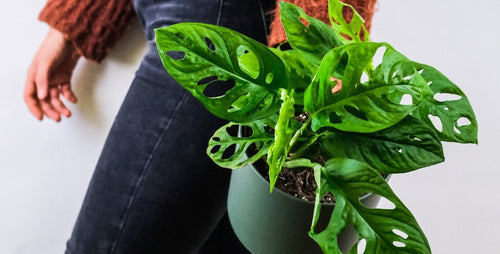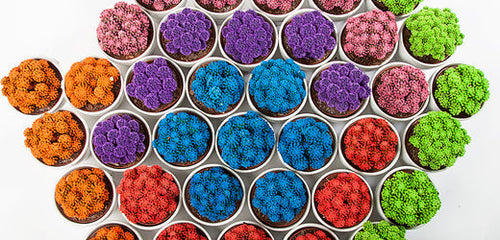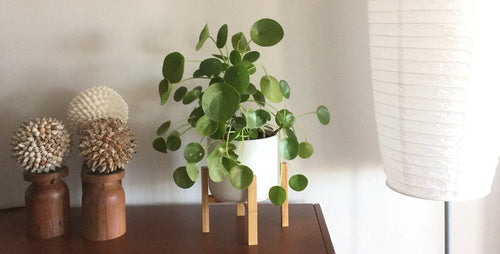Light for Houseplants
Light for Outdoor Plants
Watering Houseplants
Watering Outdoor Plants
The Wick & Grow® Self-Watering System
Humidity & Houseplants
Repotting Houseplants
Fertilizing Houseplants
Light for Houseplants
Plant tags usually define light in terms like bright, medium, and low. But they don’t usually have space to define the terms. Here’s how to determine light levels in your home.
- Bright Light: Within 3 to 4 feet of a good-sized unobstructed east-, west-, or south-facing window where the plant casts a moderately strong shadow much of the day. If you have a light meter to measure, it’s at least 500 footcandles.
- Medium Light: Within 4 to 6 feet of an obstructed east- or west-facing window (or 3 to 4 feet from a north-facing window) where the plant casts a soft shadow much of the day. If you measure with a light meter, it’s in the 200-500 footcandles range.
- Low Light: 6 feet or more from an east- or west-facing window or more than 4 feet from a north-facing window. Plants may cast little to no shadow in low light. When measured, it’s less than 200 footcandles.
There are a couple of important considerations when it comes to light.
-
Don't base brightness based on one single point of the day. Plants take in light cumulatively. If a spot has bright for a half hour, but then is obstructed the rest of the day, you shouldn’t consider it bright.
-
Plant tags usually tell you the least amount of light a plant tolerates. Almost all houseplants appreciate more light than less. Feel free to put “low-light plants” in brighter spots. Unfortunately, the converse isn’t true. “High-light plants” will not do as well in dimmer spots.
-
Depending on where you live and how acclimated your plants are to sunlight, direct sun hitting their leaves may cause sunburn. You’ll often see reference to “indirect light,” meaning the light is filtered or softened.
Light for Outdoor Plants
Outdoors, plants are usually defined as sun and shade.- Full sun refers to a spot that receives about 6 hours or more of direct sunlight per day.
- Partial sun (or partial shade...these terms are often used interchangeably) is a location that receives about 3 to 6 hours of direct sun per day.
- Shade means a spot receives less than 3 hours of direct sun per day.
Factors like temperature and time of day can impact a plant's ability to grow in sun. For example, a shade plant may be able to grow in 2 hours of direct late afternoon sun in Washington state, but that same plant may struggle in 2 hours of direct sun in South Florida. Likewise, a particular plant may be fine in 6 hours of sun if the soil stays moist. That same plant may suffer if there are droughty conditions.
Watering Houseplants
Plants use different amounts of water based on their environment. One factor that influences water needs is light, for example. The more light a plant receives, the faster it will grow, and the more water it needs.
The key to properly watering your houseplants is knowing how much to let the potting mix dry before you water again. Potting mix is made of fibers that hold moisture; plant roots absorb this moisture. There are air spaces between these pockets. If the potting mix stays too moist for too long, there’s more moisture than air in these pockets and plant roots suffocate, die, and rot.
- To find the happy medium between too much and not enough moisture, start by watering your plant when the top inch or two dries to the touch.
- See how long it takes that amount of moisture to be absorbed before the top inch or two is dry again.
- If you find it easiest to build a routine, tailor the amount of water you add at one time to be absorbed by the plant within a week.
Note: Some plants like to dry down more than just a couple of inches between waterings and may be suited to being watered every other week to ensure the roots don’t drown .
Get more on watering houseplants.
Watering Outdoor Plants
Water outdoor container plants as the top half or so of the potting mix dries to the touch. How much or often that is depends on factors like temperature, wind, and the size of the container, and the type of plant. In hot or windy conditions, a containerized plant may need watering every day.
For plants grown in the ground (landscape, garden beds, or borders), you'll commonly see a recommendation of adding about an inch of water per week. How much is that? Place a tuna can in your yard and see how long it takes a sprinkler to fill it.
This inch per week recommendation is a very general recommendation and varies based on your soil type (clay soil, for example, holds moisture longer than sandy soils), plant type, etc. Drought-tolerant plants can tolerate drier soil, for example. And in hotter, drier weather, soil moisture evaporates faster than in cooler conditions.
Tip: All plants --- even drought-tolerant varieties --- need consistent moisture right after they're planted. This allows them to become established.
The Wick & Grow® Self-Watering System
The Wick & Grow® self-watering system takes the guesswork out of watering by ensuring your plant maintains its ideal moisture level. This prevents over- or underwatering.
When using this self-watering system, it’s important to let the system (the wick) do all the work. Avoid watering your plant from the top while the wick is also in water as this can throw off the balance and cause overwatering.
Note: You can add liquid fertilizer to your water reservoir so the plant receives both moisture and nutrition.
Learn more about Wick & Grow®.
Humidity & Houseplants
A lot of tropical houseplants will appreciate about as much humidity as they can get indoors given they come from environments with high relative humidity levels. Many will tolerate average relative humidity (40 to 50 percent), though some thin-leaf varieties may struggle, particularly if the humidity is below about 50 percent and they also dry out more than they prefer.
Using a small humidifier near your plants is the best way to increase relative humidity levels. You can also group plants together (they release moisture in the air through transpiration, so they can help humidify one another) or grow them under cloches or in plant cabinets.
You'll often see the recommendation to mist your houseplants, but in most homes, this doesn't increase humidity levels appreciably. Misting may also increase growth of fungal or bacterial disease.
Repotting Houseplants
Most houseplants are highly tolerant of being rootbound. But repotting before they reach the point of being rootbound ensures optimal growth.
- How do you know when a plant is rootbound? When you slide a plant out of its pot and you see about 75 percent roots and 25 percent potting mix .
- What size container should you repot into? Look for one that's one size up (2 to 4 inches) wider than the old pot. Why? Going from a small pot to a really large pot can result in the potting mix holding too much moisture between waterings, causing root rot .
Get step-by-step repotting tips.
Fertilizing Houseplants
Unlike your plants' water and light needs, fertilizer requirements are not as clear cut. There are two main categories of fertilizer:
-
Time-release fertilizer slowly releases a steady supply of nutrients to your plants over time. They're usually formulated as granules or spheres (called prills), but may come in other forms.
-
Water-soluble fertilizer is mixed with water and applied was you water your plants. They provide more nutrients at one time, and you're more likely to see a burst of growth after using them.
No matter which type of fertilizer you choose, never exceed the recommended rates on product's label. Different products have different application rates/frequencies. Using more fertilizer than the product packaging recommends can result in too many nutrient salts in the soil that burn and potentially kill plant roots.
You can always use less fertilizer than the packaging recommends, particularly if your plants don't get a lot of light. (Light fuels growth, so the more light they get, the more fertilizer they appreciate.) Most houseplants will survive being fertilized only once every year or two, but grow best and fastest if fertilized regularly .
Written by Justin Hancock

















